The calculation of the product of values in the database (a group of cells containing column headers and related rows) is accomplished through Excel’s DPRODUCT function.
- What is DPRODUCT Function in Excel?
- How to use DPRODUCT function for Single Criterion in Excel?
- Apply DPRODUCT function with Column Label in Field Argument in Excel.
- Applying DPRODUCT Function with Wildcards in Excel.
- How to use DPRODUCT function with Column Index Number in Field Argument in Excel?
- Apply DPRODUCT Function for Multiple Criteria.
- Limitations of using DPRODUCT function in Excel.
1. What is DPRODUCT Function in Excel?
The DPRODUCT function is a database function built into Excel. DPRODUCT generates the PRODUCT of database values with various conditions. A table is used to specify the functions’ requirements, and it must have the same fields or headers as the database. By utilizing the DPRODUCT function, it is possible to return the PRODUCTS of a field. The DPRODUCT function takes the criteria in table form with the same fields as in the database.
Syntax of DPRODUCT: = DPRODUCT(database, field, criteria)
database: This encompasses all cells in the database or table. Must be a combination of column labels and data rows.
field: The column in the database where the value to be multiplied is indicated by this. It is possible to use column numbers or label the columns.
criteria: The set of cells defines the prerequisites for the data to be incorporated in the multiplication process. Each column in the conditions section should have a database field label and its associated condition.
2. How to use DPRODUCT function for Single Criterion in Excel?
Step 1: First, create a table of some fruit’s names. There is only one criterion in the criteria table here. The name of the fruit must be Cherry.
Place the fruits name into the excel sheet.

Step 2: Now, add the column in A8,A9 ,B8, B9 and C8,C9 to get the DPRODUCT result there.
The column has been added.
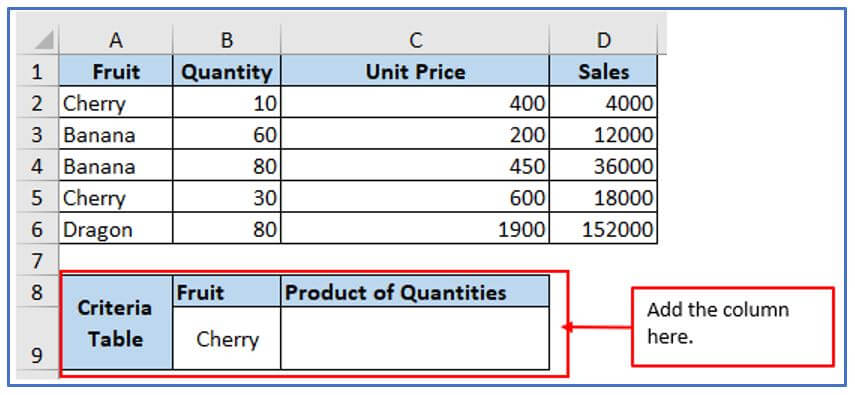
Step 3: Now, use the formula of DPRODUCT function. The formula is:
=DPRODUCT(A1:D6,B1,B8:B9)
A2:D6 and B8:B9 are the range of criteria tables.
Apply the formula here.
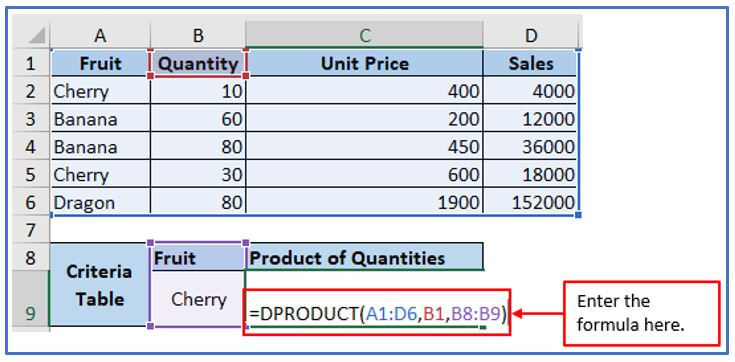
Step 4: Press the enter button and you will get the DPRODUCT result MEANS the quantity of the APPLE.
The result is 300.

3. Apply the DPRODUCT function with Column Label in Field Argument in Excel.
Field arguments can take three different types of input.
They are listed below.
Use the Column Label option to provide field arguments for the DPRODUCT function in this section. The column label is simply the heading of the column containing the values you want to multiply. Then follow the steps given below.
Step 1: Suppose you have obtained sales data. Now, enter these data into your Excel.
Entered the data here.

Step 2: Now, add the columns in A15 and A16 to get the Product of Quantities there.
The column has been added.

Step 3: Now, use the formula as shown below. The formula: =DPRODUCT(A2:D10,”Quantity”,A12:C13)
A2:D10 and A12:C13 are the range of criteria tables.
Apply the formula here.
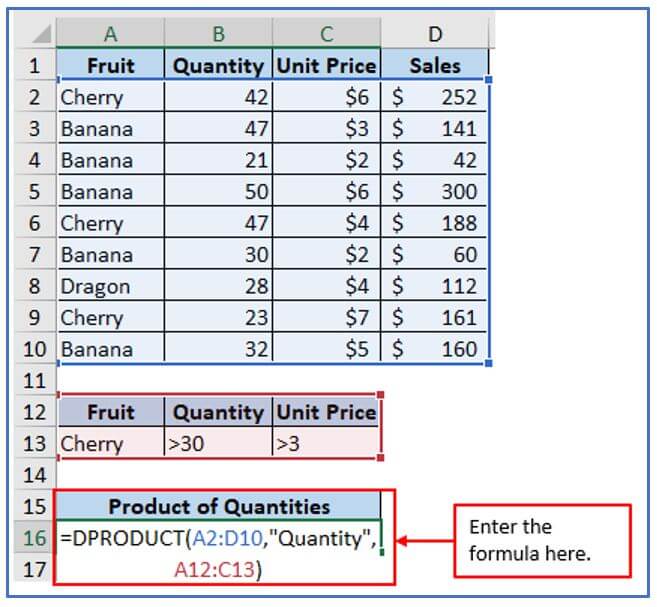
Step 4: Here is the result outlined below.
The result is $1,974.
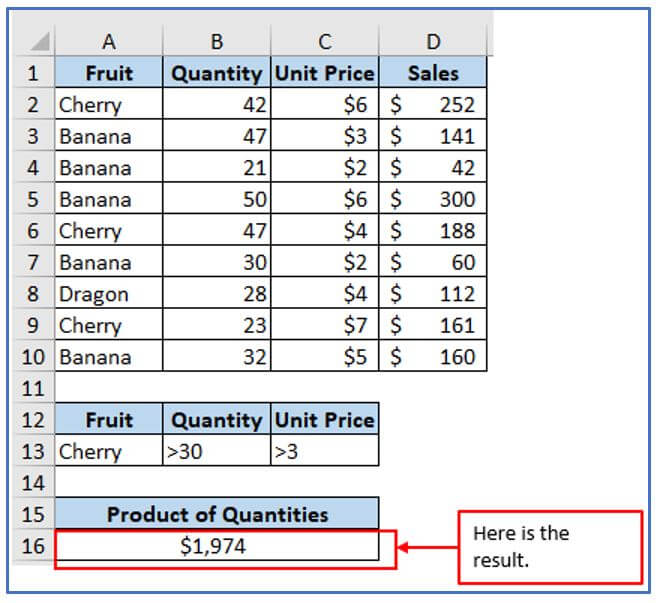
4. Apply DPRODUCT Function with Wildcards in Excel.
Step 1: – Create a data table with the information as shown below. Here,
*na means the fruits whose names end with “na”.
>=30 means the quantity can be greater than or can be equal to 30.
>3 means the unit price should be greater than 3.
All the information has been written here.
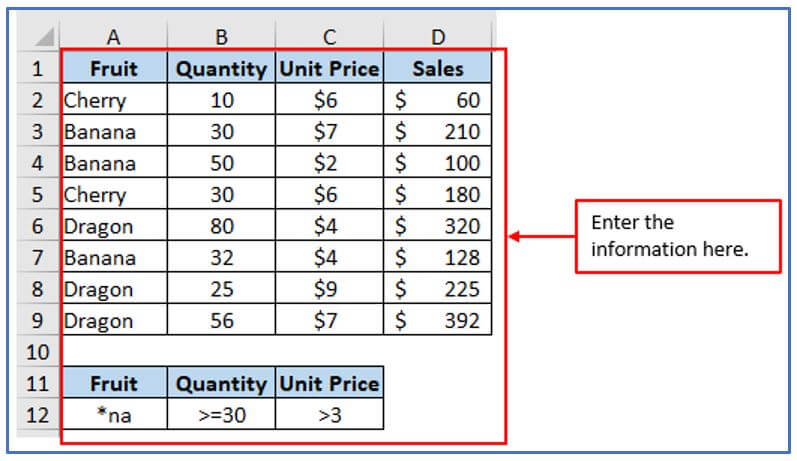
Step 2: Add the column here from A14 and A15 to get the result of Product of Quantities there.
The column has been added.
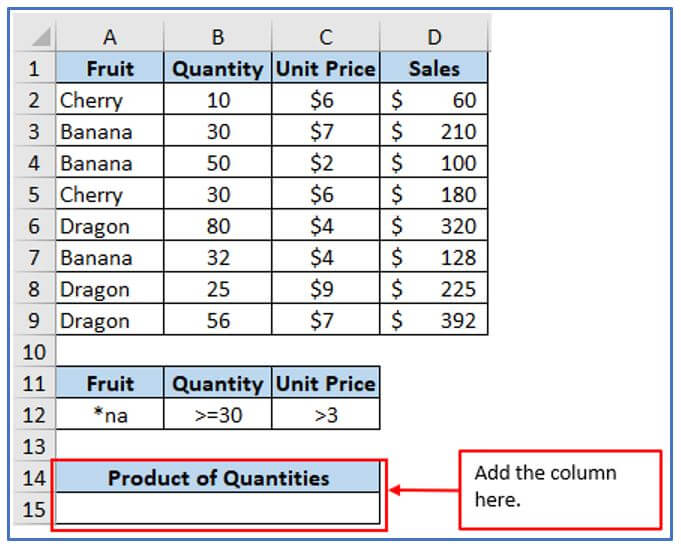
Step 3:- Use the formula now. The formula is: =DPRODUCT(A2:D9,B1,A11:C12)
A2:D9 and A11:C12 are the range of criteria tables
Used the formula here.

Step 4: Now, press enter and the result will come out.
Here is the result below.
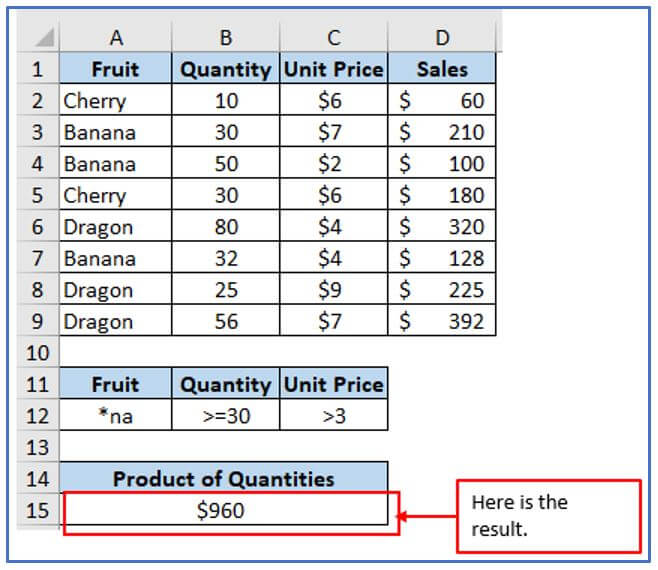
5. How to use DPRODUCT function with Column Index Number in Field Argument in Excel?
Step 1:- Provide a field argument for the DPRODUCT function by considering the column index number. A column’s index number is the serial number of the column that contains the values you want to multiply. It should be noted that the first column of the chosen database is indexed. The column’s index number can be 2 when the value from the Quantity column is utilized, as an illustration. However, if you use the value from their Price column, the index number will be
Step 1: Make a data table with some fruit names, quantities unit price, and sales and make a criterion from those information’s.
Place the information here below.

Step 2: Add one more column in A14 and A15 to get the Product of Quantities.
Add the column here.
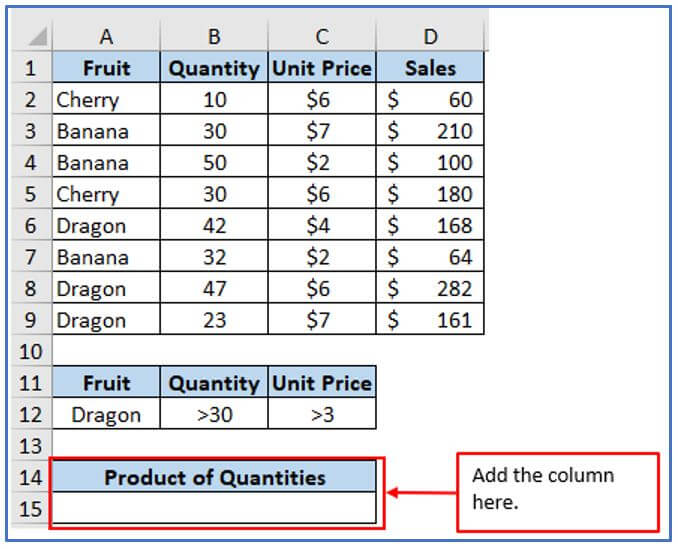
Step 3: – Now, use the formula. The formula: =DPRODUCT(A1:D9,2,A11:C12)
The formula has been applied here.
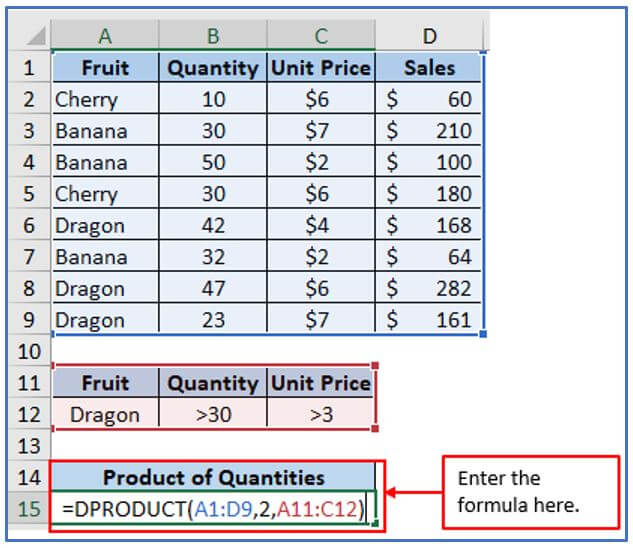
Step 4: After using the formula press enter button.
Here is the result below.
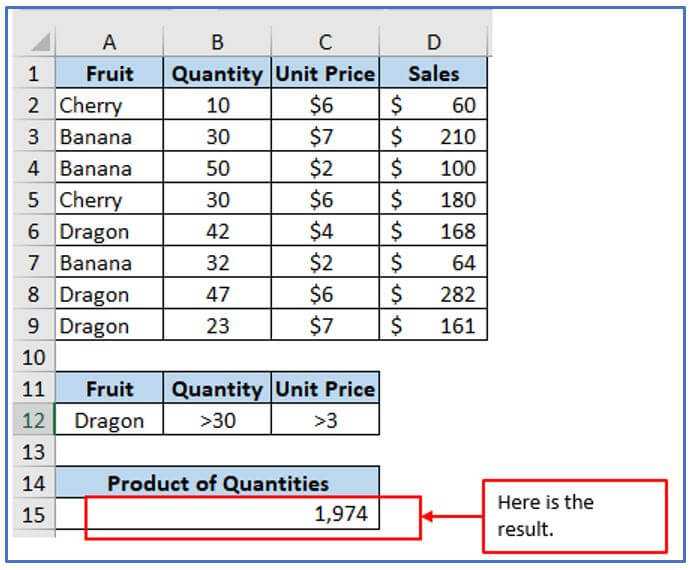
6. Apply DPRODUCT Function for Multiple Criteria.
Step 1: Organize the data, and make a table in the Excel sheet as shown below.
Place the information here.

Step 2: Choose the columns in A15 and A16 to get the Product of Quantities there as instructed below.
The column has been added.
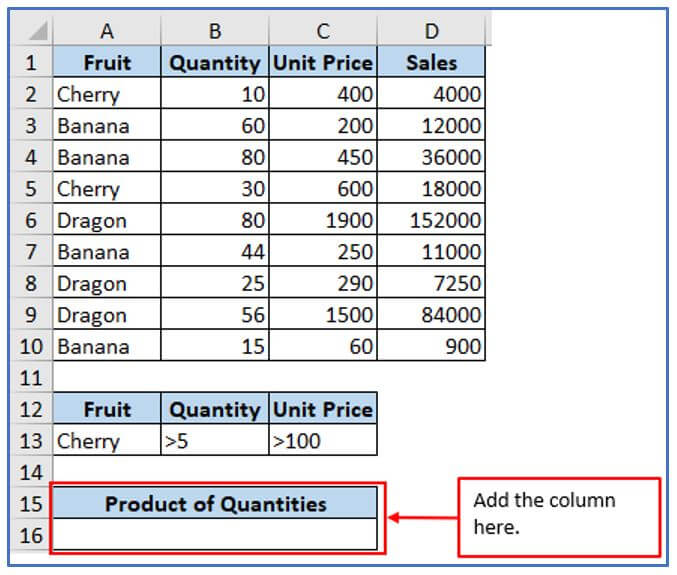
Step 3: Now, use the formula for Multiple Criteria =DPRODUCT(A1:D10,B1,A12:C13)
Apply the formula here.
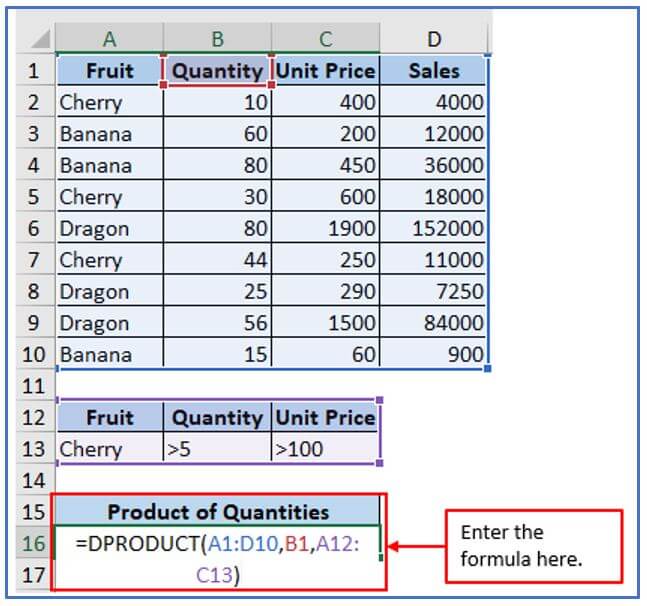
Step 4: Here is the Product of Quantities for Multiple Criteria.
Here is the result below.
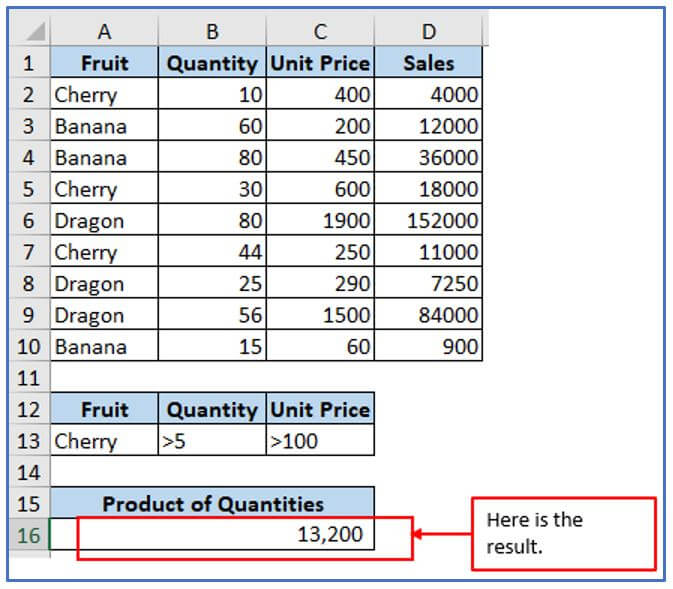 7. Limitations of using DPRODUCT function in Excel.
7. Limitations of using DPRODUCT function in Excel.
DPRODUCT is an Excel macro that can be used to calculate products based on specific criteria in your database, but it has some drawbacks.
- Database structure requirements: Data must be arranged to function with DPRODUCT.
- Alike structure with database column headings. This does not necessarily match the format of the raw data and requires additional work to prepare the dataset for analysis.
- Flexibility Limitations: The primary goal of DPRODUCT is to multiply treat values in a database that satisfies some criteria. There is no flexibility to perform other types of calculations or aggregations required for analysis.
- The condition must match exactly: The condition specified in the DPRODUCT function must match exactly the value in the database. Inconsistencies and discrepancies in data can lead to unexpected results and calculation errors.
- Single result only: DPRODUCT returns a single result based on the specified criteria. No summary or breakdown of how the results are calculated is provided, which may limit their usefulness for further analysis.
- Performance issues with large datasets: DPRODUCT has performance issues when working with large datasets, especially when the database structure is complex or when the condition results in a large number of matching records.
- Non-dynamic: Unlike other Excel functions such as SUMIFS and AVERAGEIFS, DPRODUCT does not update automatically when the underlying data changes. If you make changes to your records, you must manually update the function or adjust the criteria.
- Limited error handling: An error may occur if there is a problem with the condition or no matching record, which can be resolved by using DPRODUCT. Although Excel has error handling mechanisms such as IFERROR, managing errors in complex formulas can be a pain.
- Compatibility issues: Only Excel supports the use of the DPRODUCT function, which may not be compatible with other spreadsheet programs, making your analysis more portable.
Although there are some limitations, DPRODUCT can still be useful for calculations in Excel, particularly for working with structured datasets that require product-based aggregation based on specific criteria. However, it is important to be aware of these limitations and consider alternative approaches and features if your analysis is limited.
You may be interested:
